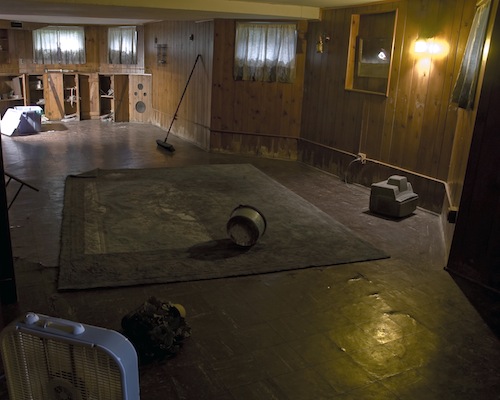Heather Mekkelson: The Flood that Never Came

The following essay was originally published in Art21 in May, 2013.
It was the summer of 2008. It was hot. And humid. Everything was green and/or sweating. People who didn’t sweat stood out. Their reserve both enviable and mysterious—a contrast from everything else. Refuge from the heat was similarly impressive and constantly sought. Most apartment galleries were barely tolerable for their heat. At cooler exhibition sites, visitors inevitably took considerable time examining the works of art on display. That August, Heather Mekkelson had a solo show at an apartment gallery—or what maybe we should call a basement gallery—half a flight downstairs in Logan Square called Old Gold. With its dark 1970s style wood paneling, built-in bar and enough floor space for a pool table, Old Gold looked like an old rumpus room. It was anything but neutral and its unapologetic, undeniable character forced artists to continually incorporate the space into their exhibitions. Mekkelson’s project was no different. Limited Entry was based entirely on the unique environment. And at that particular time, it was significantly cooler than anything outdoors.
In order to access the stairs down to the gallery, one walked through a front gate and around the side of an apartment building. According to rumor, the landlord and upstairs resident did not know Old Gold existed. Being an unpredictable fellow, gallery directors Kathryn Scanlan and Caleb Lyons preferred to keep the professional aspect of their curatorial project discreet. They didn’t advertise much and the only label on the door was composed from Home Depot stickers, appearing more like the absent-minded work of a teenager than anything formally significant. This place was easy to miss.
He would be right. Mekkelson imbues objects with an artificial memory. There was never any flood in this room; prior to their experience in Mekkelson’s studio, all of the objects were brand new. The distress they wear is therefore artificial, and yet once one draws that conclusion, the fabrication of distress becomes newly fascinating. Mud, dried in drips transforms a paperback book into an abstract composition. Each object, carefully rendered offers a unique meditation on corruption. The line of the watermark around the room boasts a bizarre authority—tying the mess together and thereby suggesting the inner logic of this still life. And is this kind of illusory composition so different from the exercise of perspective in a realist painting? Except in this case the art does not recreate a “real” scene (via painting or photography, for instance). Instead, Mekkelson’s “sculptures” must consume and destroy the real things they once were in order to become art objects. Once-useful objects must be rendered useless in their transformation into art. By firmly creating a sensation of flux—a room before it is put back together—Limited Entry suspends time. One’s ability to return to this room again and again over the course of the exhibit gives the viewer access to typically ephemeral, disembodied and often desperate moments of crisis. To contemplate the ensuing desire to move on and get things back to their proper place. To clean up the mess. Again, what might especially aggravate our landlord—a man who by his very profession hastens to maintain and fortify domestic security.
Images of Hurricane Katrina have joined up with the more recent footage of Japan’s 2011 tsunami, and Hurricane Sandy. Perhaps what is strangest about those historic events is that they are fleeting, leaving behind ghosts, mineral deposits, and technical difficulties. Despite the static network of objects, Limited Entry was, like any other show, even more ephemeral. Aside from an old listing on Artslant and a review in New City it has more or less disappeared without a trace. Shortly after the exhibit closed, signs of Mekkelson’s presence were erased—even that watermark disappeared. Old Gold doesn’t exist anymore either. It’s former directors have moved west, relocating to Los Angeles. Probably the basement has resumed its life as a rec room retreat. Perhaps the landlord has new tenants that exacerbate or sooth his disposition in turns. He might regard the residue of their backyard parties with similar suspiciousness, but likely thinks little of the basement flood he once thought he’d witnessed. Probably my recollection of this exhibit is off as well, with glitches, inaccuracies, and exaggerations due to time. Certainly my portrayal of the landlord is wrong. I never met him. I should add too, I don’t put much stock in the long-stale rumor about his disposition either. For all I know he came to every opening. What lingers for me, however, as a kind of auratic residue, is the idea that my own account for what took place is perhaps not so different than whatever story the objects in that room conveyed. Honest and false memories mix themselves up, without evidence to differentiate.